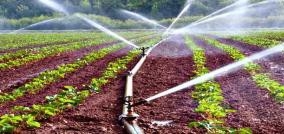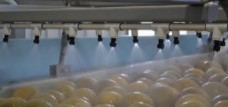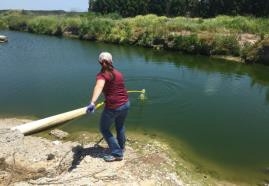Food Safety Modernization Act Produce Safety Rule: Agricultural Water
ID
FST-271NP
Overview
The Produce Safety Rule (PSR) is one of the seven food safety regulations that are part of the Food Safety Modernization Act (FSMA). The PSR sets a series of standards for the safe growing, harvesting, packing, and holding of produce grown for human consumption: 21 Code of Federal Regulations Part 112 (https://www.federalregister.gov/documents/2015/11/27/2015-28159/standards-for-the-growing-harvesting-packing-and-holding-of-produce-for-human-consumption). Similar to the other FSMA rules, the PSR aims to be proactive rather than reactive by focusing on high risk practices and identification of hazards within individual operations. For example, there are no requirements for uncontrollable factors, such as wildlife. Standards are set for: agricultural water; biological soil amendments; sprouts; domesticated and wild animals; worker training, health and hygiene; and equipment, tools, and buildings. Here, we describe the PSR standards for agricultural water.
Agricultural Water
The PSR standards (subpart E) define agricultural water as “water that is intended to, or likely to, contact the harvestable portion of covered produce or food-contact surfaces”. The PSR divides the water standards into two categories: production and harvest & post-harvest activities. Additionally, agricultural water sources and water distribution systems must be inspected (annually) and maintained (as needed).

1. Production agricultural water activities include irrigation, fertigation, frost protection, crop sprays, and dust abatement, among others.

2. Harvest & Post-Harvest agricultural water activities include cooling, washing, ice-making, waxing, handwashing, commodity movement, cleaning and sanitizing, among others.
Production Water
Production water that is applied directly to covered produce must be evaluated using a microbial water quality profile (MWQP) for each water source. MWQPs consist of calculations for Geometric Mean and Statistical Threshold Value based on generic Escherichia coli (E. coli) levels in 100 milliliters. Generic E. coli is used as a sign of fecal contamination (high numbers may indicate high levels of contamination). The timeframe to establish the initial MWQP is 2-4 years based on operation/farm compliance dates. The MWQP Geometric Mean and Statistical Threshold Value must be less than or equal to 126 CFU E. coli and 410 CFU E. coli per 100 ml of water, respectively. Water sample numbers and testing frequencies differ for the types of water (for example, surface vs. ground vs. municipal).
DEFINITIONS
GM: Geometric Mean is the central tendency of the water quality, so it represents the average amount of E. coli in the samples.
STV: Statistical Threshold Value is the point at which 90 percent of the samples are below the value. It is essentially the variability of the samples.
CFU: Colony Forming Unit is the number of E. coli in the sample
MPN: Most Probable Number is another unit used to estimate the number of E. coli in the sample
Tools are being developed to aid growers in calculating these values. Water that is used to irrigate sprouts does not fall under this rule. It must contain zero generic E. coli (see Sprout Safety Alliance via www.fda.gov).
1. Untreated Surface Water:
The PSR requires that a MWQP be established for each untreated agricultural surface water source that is applied directly to produce.

To establish the initial WQP:
Twenty water samples must be taken over a period of 2-4 years during the growing seasons
The GM and STV for generic E. coli are calculated from these samples (standard: less than or equal to 126 CFU E. coli (GM) and 410 CFU E. coli (STV) per100 ml)
After initial WQP is established:
Five samples must then be taken annually and combined with the most recent 15 samples to calculate a new GM and STV to confirm that the water is still meeting the standards (rolling MWQP)
2. Untreated Ground Water:
The PSR requires that a MWQP be established for each untreated agricultural ground water source that is applied directly to produce.
To establish the WQP:
- Four water samples must be taken during one growing season
- The GM and STV for generic E. coli are calculated from these samples (standard: less than or equal to 126 CFU E. coli (GM) and 410 CFU E. coli (STV) per 100 ml)
After initial WQP is established:
- One sample must be taken annually and combined with the three most recent samples to calculate a new GM and STV to confirm that the water is still meeting the standards (rolling MWQP)
3. Treated (for example, municipal) Water:
What if my Water Does Not Meet the Standards?
Three types of corrective measures are allowed if the MWQP does not meet water standards. These actions include:
Apply a time interval for microbial die-off (either between last application of water and harvest and/or between harvest and the end of storage and/or removal during activities such as commercial washing
Re-inspect the water system, identify problems, and make necessary changes and confirm effectiveness
Treating the water
Contact your local extension agent or specialist for more information and assistance
The PSR does not require a MWQP be established for each treated agricultural water source that is applied directly to produce. Any treatment used must be a validated process to ensure that it kills enough bacteria. Also, this water must be monitored to ensure the treatment is working. If water from a public water system (e.g., municipal) is used, obtain a certificate from the public water operator to verify treatment is compliant with the PSR.
Harvest and Post-Harvest Water
Harvest & post-harvest water must have no detectable generic E. coli. If generic E.coli is detected, use of that water source will be immediately discontinued and follow-up actions will be taken to meet the standard.
1. Untreated Surface Water:
The PSR states untreated surface water can not be used for harvest and post-harvest water activities.
2. Untreated Ground Water:
The PSR requires each untreated ground water source that is used in harvest and post-harvest water activities be tested during an initial year and annually thereafter.
Initially:
- Four water samples must be taken during one growing season (or over the period of a year)
- Standard: zero detectable generic E. coli per 100 ml
Subsequent years:
- At least one water sample must be taken during the growing season (or over the period of a year)
If water test results ever exceed the standard (zero detectable generic E. coli per 100 ml); water sampling must be resumed to at least four times per growing season (or year).
3. Public Water System:
The PSR has no requirement to test water that originates from a public water system; obtain a certificate from the public water operator to verify treatment is compliant with the PSR.
Recordkeeping

The PSR will require growers to keep records for each of their water sources used for production and harvest/post-harvest activities. Examples of some documents growers may be required to maintain include findings of the water system inspection, water test results, monitoring water treatments, corrective measures taken (if any), certificate from the public water system (if used), among others.
Reference
US Food and Drug Administration Office of the Federal Registrar. 2016.
Standards for the Growing, Harvesting, Packing and Holding of Produce for Human Consumption. Available from: https://www.gpo.gov/fdsys/pkg/FR-2015-11-27/pdf/2015-28159.pdf. Accessed March 17, 2017.
Virginia Cooperative Extension materials are available for public use, reprint, or citation without further permission, provided the use includes credit to the author and to Virginia Cooperative Extension, Virginia Tech, and Virginia State University.
Virginia Cooperative Extension is a partnership of Virginia Tech, Virginia State University, the U.S. Department of Agriculture (USDA), and local governments, and is an equal opportunity employer. For the full non-discrimination statement, please visit ext.vt.edu/accessibility.
Publication Date
September 29, 2022



